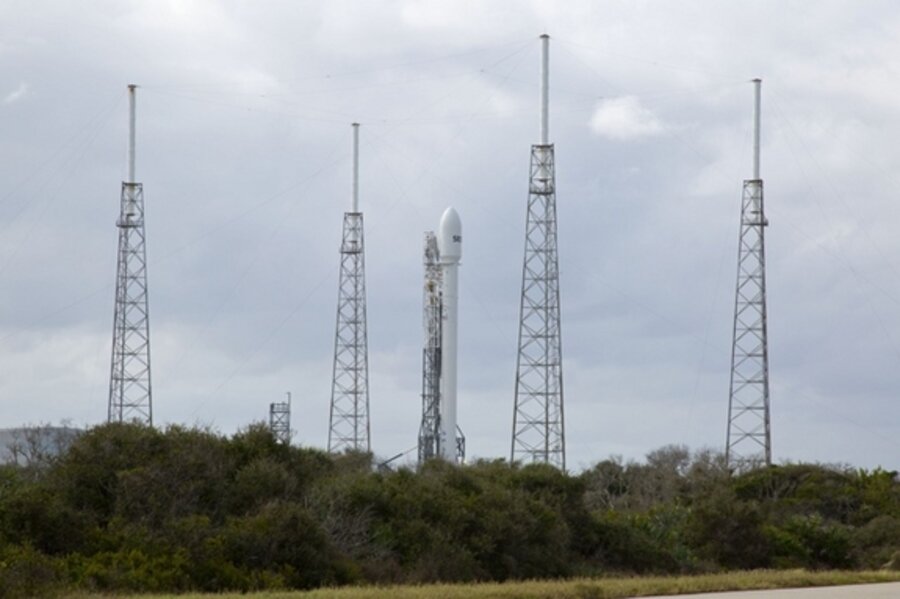SpaceX puts off highly-anticipated launch, citing technical glitch
Loading...
The private spaceflight company SpaceX delayed the launch of its first commercial communications satellite mission Monday (Nov. 25) due to an unspecified technical glitch with the flight's Falcon 9 rocket.
SpaceX aimed to launch the Falcon 9 rocket at 5:37 p.m. EST (0027 Nov. 27 GMT) from the Cape Canaveral Air Force Station in Florida to send the huge SES-8 communications satellite into orbit for its customer, the satellite operator SES World Skies. But apparent glitches with the rocket pushed the liftoff time back by nearly an hour before an issue on the Falcon 9's first stage force SpaceX to call off the launch attempt.
"We observed unexpected readings with the first stage liquid oxygen system so we decided to investigate," SpaceX officials said in a statement. "The launch vehicle and satellite are in great shape and we are looking forward to the next launch opportunity on Thursday at 5:38 p.m. Eastern time (0038 Nov. 28 GMT)." [Photos: SpaceX's improved Falcon 9 rocket soars on 1st flight]
SpaceX officials said they won't try to launch until Thursday (Nov 28) due to the Federal Aviation Administration, which wanted to avoid shutting down commercial air traffic along the Florida coast during the busy Thanksgiving holiday travel period to support to the launch, according to CBS News.
Monday's launch try marked SpaceX's first attempt to launch its upgraded Falcon 9 rocket from its Florida launching site. Known as the Falcon 9 version 1.1, the 224.4-foot (68.4 meters) rocket booster includes a series of enhancements over SpaceX's baseline Falcon 9 booster, such as a circular "Octaweb" first-stage engine arrangement, triple-redundancy avionics and a larger payload fairing 17 feet (5.1 meters) wide and tall enough to fit a bus inside.
The upcoming launch will mark SpaceX's first entry into the market of large commercial satellite launches. The SES-8 satellite is a 6,918-lb. (3,137 kilograms) high-definition communications satellite destined for a transfer orbit that soars flies 183 miles (295 kilometers) above Earth at its nearest point and more than 49,709 miles (80,000 km) at its highest. The SES-8 satellite is hybrid Ku-and Ka-band spacecraft designed to provide high-definition telecommunications services to customers across the South Asia and Pacific region.
The Falcon 9 v1.1 rocket made its debut launch on Sept. 29, when it lofted the Canadian Space Agency's space weather monitoring satellite CASSIOPE into orbit from a pad at California's Vandenberg Air Force Station. While that mission successfully delivered the CASSIOPE into its intended orbit, an attempt to restart the upgraded Falcon 9 rocket's second stage engine failed due to a frozen igniter fluid line.
The ability to restart the second stage engine is key to delivering the SES-8 satellite into its intended geostationary transfer orbit. SpaceX officials said they added more insulation to the affected fluid line to prevent the glitch from occurring again.
SpaceX's Falcon 9 rocket is also designed to launch the company's Dragon space capsules on missions to the International Space Station. SpaceX has a $1.6 billion contract with NASA to provide 12 commercial cargo delivery flights to the space station. The company has already flown two of those missions, with the third slated to launch in February.
SpaceX is also developing a manned version of the Dragon spacecraft and is competing with other spaceflight firms to ferry astronauts to and from the International Space Station using the commercial space capsule.
Visit SPACE.com for updates on the SpaceX next-generation Falcon 9 rocket launch. SPACE.com partner Spaceflight now is also offering updates via its SpaceX Mission Status Center, which will also include a launch webcast.
Email Tariq Malik at tmalik@space.com or follow him @tariqjmalik and Google+. Follow us @Spacedotcom, Facebook and Google+. Original article on SPACE.com.
- The Rockets and Spaceships of SpaceX (Photos)
- Video Captures SpaceX's 'Re-Lightable' Engine
- 6 Fun Facts About Private Rocket Company SpaceX
Copyright 2013 SPACE.com, a TechMediaNetwork company. All rights reserved. This material may not be published, broadcast, rewritten or redistributed.







